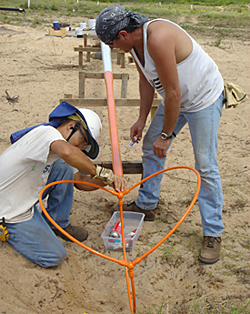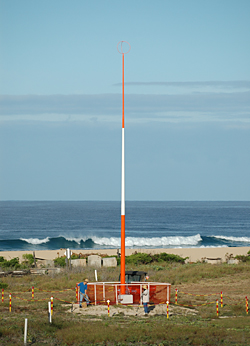|
NIST Radio Station WWVH in Hawaii Gets Antenna Makeover
 |
| Dean Takamatsu of the NIST WWVH staff (left) and John Lowe, leader of the NIST Time & Frequency Service Group, assemble a 15 MHz fiberglass antenna for radio station WWVH in Hawaii. Credit: A. Ochinang/NIST |
| |
| |
 |
| NIST staff tend the grounds around a 10 MHz fiberglass antenna at Barking Sands Beach near Kekaha on the island of Kauai, Hawaii. Credit: D. Okayama/NIST |
Radio station WWVH in Hawaii, operated since 1948 by the National Institute of Standards and Technology (NIST) to broadcast time, frequency and other announcements, recently powered up innovative replacement antennas.
In a seven-year project to adopt a technology used on Navy ships, NIST has installed new antennas encased in fiberglass rather than traditional steel supports, to resist corrosion from the salty ocean air. The fiberglass design will reduce maintenance and repair costs. The new design also enables the flexible, lightweight antennas to be easily lowered to the ground for maintenance, reducing safety hazards to staff who previously had to climb the towers, which are up to 98 feet tall. The improved antennas should reduce signal downtime for WWVH users.
From its location on the island of Kauai, WWVH broadcasts on four different frequencies. Each frequency requires a different antenna; including backups, the station has a total of eight antennas, seven of which are made of fiberglass. NIST erected and powered up the last fiberglass replacement antenna in October 2007. NIST staff believe the project is the first demonstration of high-powered, high-frequency fiberglass antennas on land.
Broadcast Information:
NIST radio station WWVH broadcasts time and frequency information 24 hours a day, 7 days a week. The announcer states the time in hours and minutes every minute “at the tone.” The information broadcast by WWVH includes time announcements, standard time intervals, standard frequencies, geophysical alerts, marine storm warnings, and Global Positioning System (GPS) status reports.
Service Area:
WWVH officially serves the Pacific Ocean and Pacific Rim but has received confirmation of reception from as far away as South Africa, a distance of 19,300 km (12,000 miles) from Hawaii. NIST’s two radio stations, including WWVH in Hawaii and WWV near Fort Collins, Colorado, essentially cover a large portion of the world between them, although reception might be difficult in some areas. NIST also operates a third radio station near Ft. Collins, WWVB, which broadcasts a special code that automatically sets consumer clocks, watches, and other timepieces to NIST time.
How to Pick Up WWVH Signals:
WWVH operates in the part of the radio spectrum known as HF (high frequency), commonly called shortwave. The station broadcasts on four different frequencies: 2.5, 5, 10, and 15 megahertz (MHz). A normal AM/FM radio will not pick up the signals (the middle of the AM radio dial is about 1 MHz and the middle of the FM radio dial is about 100 MHz), but there are many inexpensive shortwave receivers that can pick up the station. Listeners can also hear the WWVH broadcasts by telephone, by calling 808-335-4363 (a Hawaii phone number that is not toll free).
Information is broadcast at different frequencies simultaneously because these signals travel different distances as the weather and conditions of the ionosphere vary. NIST’s goal is to make at least one frequency available at all times in the service area.
More information about NIST radio station WWVH is available on the web: http://tf.nist.gov/timefreq/stations/wwvh.htm.
Additional information is also available about NIST’s other radio stations, WWV (http://tf.nist.gov/timefreq/stations/wwv.html) and WWVB (http://tf.nist.gov/timefreq/stations/wwvb.htm).
History:
WWVH began operation on Nov. 22, 1948, at Kihei on the island of Maui, in the then-territory of Hawaii (Hawaii was granted statehood in 1959). The original station site was constantly threatened by an eroding shoreline, and much of the equipment and property was damaged by the beachfront conditions. By 1965, the ocean was within a few meters of both the main building and the 15 MHz antenna, and it was obviously necessary to move. In July 1971 the station moved to its current location, a 30-acre (12 hectare) site near Kekaha on the island of Kauai.
Date
created: 01/17/08
Last
updated: 01/17/08
Contact: inquiries@nist.gov
|

